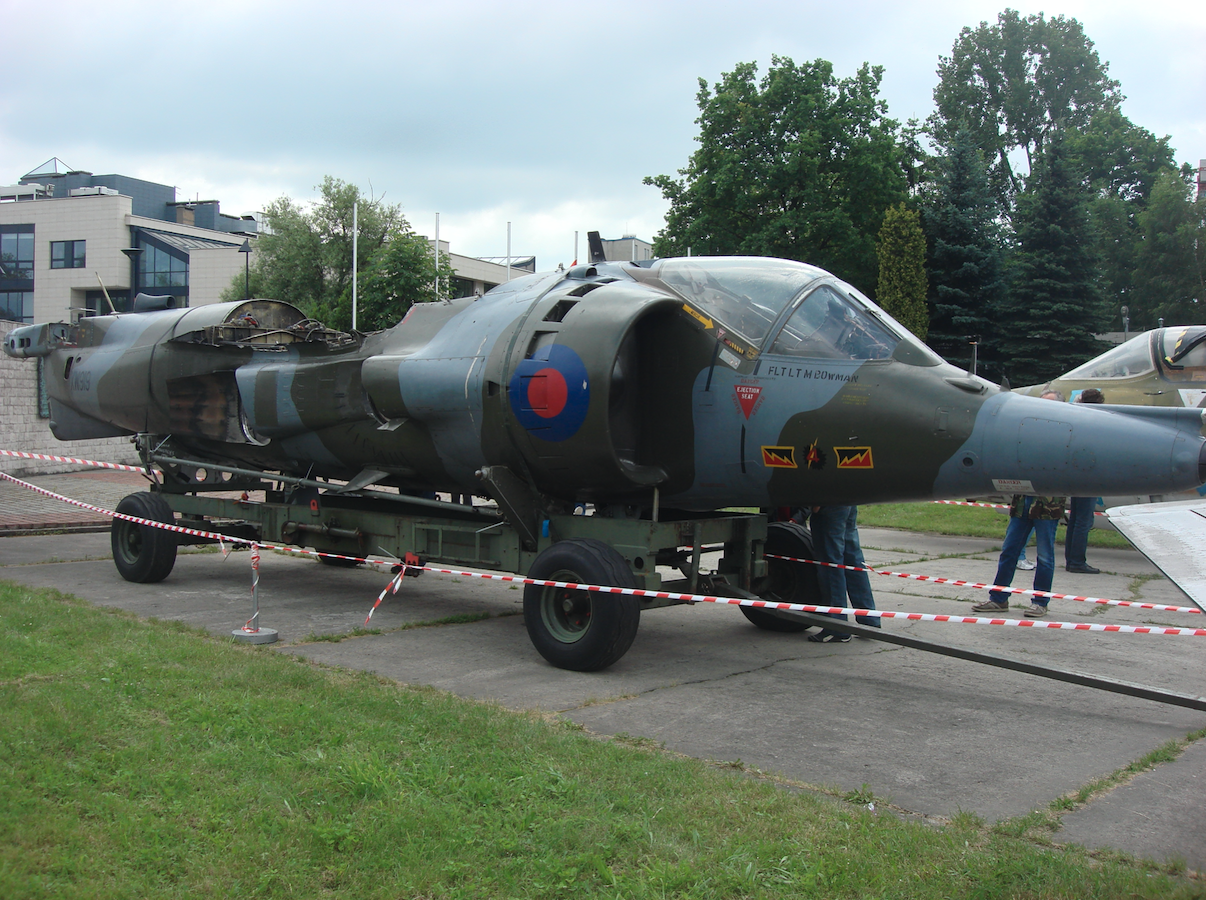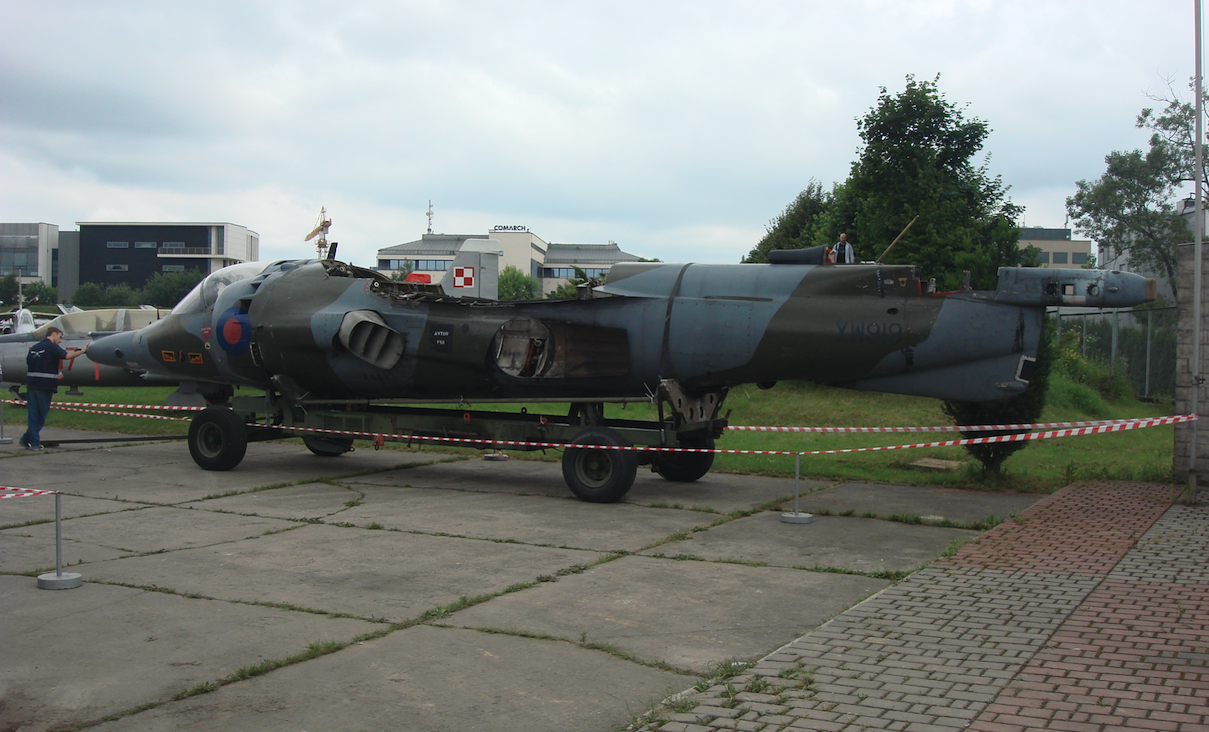Turbo-jets for powered-lifts
Rolls Royce Bristol Pegasus.
The Rolls Royce Pegasus engine is one of the most remarkable turbojets in aviation history. The Rolls-Royce Pegasus, formerly the Bristol Siddeley Pegasus, is a turbo-fan engine designed by Bristol Siddeley. The engine was specially designed for the combat aircraft that eventually became the Harrier.
The Rolls Royce Pegasus engine is built with one air intake and four exhaust nozzles (two cold air and two hot air jets). All these nozzles are movable and provide downward or backward thrust. This transition from one position to another is smooth. When the nozzles are directed downwards, the airplane may rise vertically, hover or slowly descend. If the nozzles are directed backwards, they produce forward thrust, which is normal airplane flight. This allows the plane to take off and land vertically.
When Harrier planes were sold to the US (Marines), the planes were manufactured in the US and the engines were "produced" under license as the Pratt & Whitney F402. In fact, these engines were manufactured at the Rolls-Royce plant in Bristol, England.
The history of the Pegasus engine.
Work on the engine was started by engineer Gordon Lewis from the Bristol Engine Company in 1956. The work was supervised by the technical director Stanley Hooker. There were several arrangements. The basis was initially the Orpheus motor and then the Olympus dual-flow motor. Apart from the technical difficulties that the designers had to overcome, the external atmosphere and the needs of the army were also important. In 1957, the RAF was already looking for a replacement for the Hawker Hunter combat aircraft. If his successor was able to take off vertically, the qualitative leap would be big. The engine underwent further modifications. Among other things, the inlet ducts to the outlet nozzles have been significantly shortened and the cold air outlet nozzles have appeared. Until now, all four nozzles have been hot. This resulted in a typical turbofan system, with cold external flow and hot internal flow.
In 1957, the "White Book" was published, which showed that piloted planes will not exist in the future. Missile weapons were given priority. Fortunately, the new engine was financed by the weapons development program, so it has been preserved. Aviation companies entered various mergers in order to stay on the market. Bristol Siddeley Engines Limited (BSEL) has merged with Armstrong Siddeley to provide financial backing. On September 2, 1959, the engine designated BE53 was launched. It has a two-stage fan, 6-stage low pressure, 7-stage high pressure, combustion chamber, single stage high pressure turbine, 2 stage low pressure turbine. The motor is two-spool and has four nozzles, movable.
The construction of the airframe was carried out by the Hawker company. The Hawker P.1127 airframe was built around the engine. This plane was overturned on October 21, 1960. The engine was marked BE53 / 3 (Pegasus 2). The first transition from hover to level flight took place on September 8, 1961. The military interest in the plane was enormous, although the plane was described as a toy because its lifting capacity was initially symbolic. Private funding emerged to build nine test Kastrel machines, which were subjected to extensive testing. They had Pegasus 3 and eventually Pegasus 5 engines. The plane was shown at the Paris Air Show in 1963. The decision was made on a combat aircraft program called Harrier. In 1966, the program was acquired by Rolls Royce.
At the same time, Bristol was acquired by Rolls Royce. There was already a program that was to lead to the creation of VTOL airplanes with supersonic airspeed. The engine should be 39,500 lbf (175.70 kN) thrust. However, this program was canceled as early as 1965.
In the 60’s, Indochina was the main theater of hostilities. It was noted that a VTOL combat aircraft could be useful in such conditions. Pilots of various countries flew on Kastrel planes. They submitted their comments. Therefore, the RAF decided to take the risk and in 1966, ordered an information series of 60 Kastrel machines. This is how the attack aircraft Harrier GR Mk.1 (Harrier – Marsh harrier, Marsh harrier – a species of large bird of prey from the hawk family) was finally ordered. The first flight was made on December 28, 1967, and entered service on April 1, 1969. Production continued at Kingston-upon-Thames plants in south-west London and Dunsfold.
The Pegasus engine is a two-spool, two-flow engine. Both shafts rotate in opposite directions to remove the gyro moment that would prevent the plane from hovering. The engine starts with a 3-speed low pressure fan. The fan blade tips are already developing supersonic speed. The airflow through the fan is 432 lbps. The first fan stage is positioned in front of the front shaft bearing. This solution eliminates the possibility of icing of the engine structural struts. Downstream of the fan, the air is divided into an internal hot stream and into two outlet nozzles. The high pressure turbine has an 8-stage axial compressor. Annular combustion chamber with low-pressure ASM burners. Both spools are driven by two-stage turbines. Hot gases go to two movable nozzles. The front nozzles are made of steel. The rear nozzles are made of nimonic alloy and operate at approximately 650 degrees Celsius. The air flow is divided into approximately 60% front nozzles, 40% rear nozzles. All four nozzles rotate synchronously. They are powered by pneumatic cylinders and a system of gears and motorcycle chains. The air for the actuators is taken from the high pressure compressor. The rotation of the nozzles is 98.5 degrees, which allows you to even fly backwards.
Additionally, the aircraft propulsion system has small exhaust nozzles at the ends of the wings and at the end of the fuselage. The nozzles at the end of the fuselage are responsible not only for keeping the plane horizontal but also for its rotation around the vertical axis, i.e. changing the course.
Pegasus engines have several limitations. One is the internal temperature of the engine, especially the temperature of the first stage of the turbine. Since this measurement is unreliable at this point, the exhaust gas temperature is measured at the exhaust nozzle. Temperature is realized by water injection. Here it is done differently than in classic (50-year-old) turbojets where water was injected in the compressor area to increase thrust. The Pegasus engine, on the other hand, is about maintaining a constant maximum exhaust gas temperature so as not to damage the engine. Water is injected between the combustion chamber and the turbine. The water cools the exhaust gases, increases their mass and prevents the turbine from overheating. A reservoir for distilled water was placed between bifurcated hot nozzles. The tank holds up to 500 pounds (227 kg) of H2O. Water is injected automatically, without the intervention of a pilot. The pilot only receives a signal (indicator in the cockpit) that the water level is low. Then the engine shifts to lower operating ranges and will not give maximum thrust.
The engine is centrally mounted, which seems to make it much harder to replace the engine. According to the service manual, it takes 8 hours to replace the engine, but an experienced team of mechanics does it in 4 hours.
A dozen or so versions of the Pegasus engine were created. The last of them, Pegasus 11-61 / Mk.107, was mounted on Harrier GR7 / GR9 aircraft. It has a thrust of 23,800 lbf (106 kN).
Written by Karol Placha Hetman


